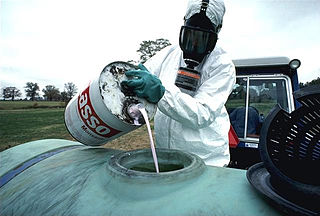
Dichlorodiphenyltrichloroethane, commonly known as DDT, is a colorless, tasteless, and almost odorless crystalline chemical compound, an organochloride. Originally developed as an insecticide, it became infamous for its environmental impacts. DDT was first synthesized in 1874 by the Austrian chemist Othmar Zeidler. DDT's insecticidal action was discovered by the Swiss chemist Paul Hermann Müller in 1939. DDT was used in the second half of World War II to limit the spread of the insect-borne diseases malaria and typhus among civilians and troops. Müller was awarded the Nobel Prize in Physiology or Medicine in 1948 "for his discovery of the high efficiency of DDT as a contact poison against several arthropods". The WHO's anti-malaria campaign of the 1950s and 1960s relied heavily on DDT and the results were promising, though there was a resurgence in developing countries afterwards.

Insecticides are pesticides used to kill insects. They include ovicides and larvicides used against insect eggs and larvae, respectively. The major use of insecticides is in agriculture, but they are also used in home and garden settings, industrial buildings, for vector control, and control of insect parasites of animals and humans.
Chlordane, or chlordan, is an organochlorine compound that was used as a pesticide. It is a white solid. In the United States, chlordane was used for termite-treatment of approximately 30 million homes until it was banned in 1988. Chlordane was banned 10 years earlier for food crops like corn and citrus, and on lawns and domestic gardens.

Dicofol is an insecticide, an organochlorine that is chemically related to DDT. Dicofol is a miticide that is very effective against spider mite. Its production and use is banned internationally under the Stockholm Convention.

Endocrine disruptors, sometimes also referred to as hormonally active agents, endocrine disrupting chemicals, or endocrine disrupting compounds are chemicals that can interfere with endocrine systems. These disruptions can cause numerous adverse human health outcomes, including alterations in sperm quality and fertility; abnormalities in sex organs‚ endometriosis‚ early puberty‚ altered nervous system or immune function; certain cancers; respiratory problems; metabolic issues; diabetes, obesity, or cardiovascular problems; growth, neurological and learning disabilities, and more. Found in many household and industrial products, endocrine disruptors "interfere with the synthesis, secretion, transport, binding, action, or elimination of natural hormones in the body that are responsible for development, behavior, fertility, and maintenance of homeostasis ."
Organochlorine chemistry is concerned with the properties of organochlorine compounds, or organochlorides, organic compounds containing at least one covalently bonded atom of chlorine. The chloroalkane class includes common examples. The wide structural variety and divergent chemical properties of organochlorides lead to a broad range of names, applications, and properties. Organochlorine compounds have wide use in many applications, though some are of profound environmental concern, with TCDD being one of the most notorious.

Persistent organic pollutants (POPs) are organic compounds that are resistant to degradation through chemical, biological, and photolytic processes. They are toxic and adversely affect human health and the environment around the world. Because they can be transported by wind and water, most POPs generated in one country can and do affect people and wildlife far from where they are used and released.

Biomagnification, also known as bioamplification or biological magnification, is the increase in concentration of a substance, e.g a pesticide, in the tissues of organisms at successively higher levels in a food chain. This increase can occur as a result of:

Dieldrin is an organochlorine compound originally produced in 1948 by J. Hyman & Co, Denver, as an insecticide. Dieldrin is closely related to aldrin, which reacts further to form dieldrin. Aldrin is not toxic to insects; it is oxidized in the insect to form dieldrin which is the active compound. Both dieldrin and aldrin are named after the Diels-Alder reaction which is used to form aldrin from a mixture of norbornadiene and hexachlorocyclopentadiene.
Derek Almey Ratcliffe was one of the most significant British nature conservationists of the 20th century. He was Chief Scientist for the Nature Conservancy Council at the Monks Wood Experimental Station, Abbots Ripton, Huntingdon, retiring in 1989. Ratcliffe was the author of the 1977 Nature Conservation Review, a document which set out the most important sites for nature conservation in the United Kingdom. He also published various works on nature and conservation.
Xenoestrogens are a type of xenohormone that imitates estrogen. They can be either synthetic or natural chemical compounds. Synthetic xenoestrogens include some widely used industrial compounds, such as PCBs, BPA, and phthalates, which have estrogenic effects on a living organism even though they differ chemically from the estrogenic substances produced internally by the endocrine system of any organism. Natural xenoestrogens include phytoestrogens which are plant-derived xenoestrogens. Because the primary route of exposure to these compounds is by consumption of phytoestrogenic plants, they are sometimes called "dietary estrogens". Mycoestrogens, estrogenic substances from fungi, are another type of xenoestrogen that are also considered mycotoxins.

Mosquito control manages the population of mosquitoes to reduce their damage to human health, economies, and enjoyment. Mosquito control is a vital public-health practice throughout the world and especially in the tropics because mosquitoes spread many diseases, such as malaria and the Zika virus.
David Beaumont Peakall was an internationally recognised toxicologist. His research into the effects of DDE and DDT on eggshells contributed to the ban on DDT in the United States. He proved that the chemicals caused thinning of eggshells, leading to a reduction in the population of various bird species. He also pioneered research on the effects of PCBs on birds.

Environmental toxicology is a multidisciplinary field of science concerned with the study of the harmful effects of various chemical, biological and physical agents on living organisms. Ecotoxicology is a subdiscipline of environmental toxicology concerned with studying the harmful effects of toxicants at the population and ecosystem levels.

The environmental effects of pesticides describe the broad series of consequences of using pesticides. The unintended consequences of pesticides is one of the main drivers of the negative impact of modern industrial agriculture on the environment. Pesticides, because they are toxic chemicals meant to kill pest species, can affect non-target species, such as plants, animals and humans. Over 98% of sprayed insecticides and 95% of herbicides reach a destination other than their target species, because they are sprayed or spread across entire agricultural fields. Other agrochemicals, such as fertilizers, can also have negative effects on the environment.

Zerovalent iron (ZVI) is jargon that describes forms of iron metal that are proposed for use in groundwater remediation.
Xenohormones or environmental hormones are compounds produced outside of the human body which exhibit endocrine hormone-like properties. They may be either of natural origin, such as phytoestrogens, which are derived from plants, or of synthetic origin. These compounds can cause endocrine disruption by multiple mechanisms including acting directly on hormone receptors, affecting the levels of natural hormones in the body, and by altering the expression of hormone receptors. The most commonly occurring xenohormones are xenoestrogens, which mimic the effects of estrogen. Other xenohormones include xenoandrogens and xenoprogesterones. Xenohormones are used for a variety of purposes including contraceptive & hormonal therapies, and agriculture. However, exposure to certain xenohormones early in childhood development can lead to a host of developmental issues including infertility, thyroid complications, and early onset of puberty. Exposure to others later in life has been linked to increased risks of testicular, prostate, ovarian, and uterine cancers.
Toxicodynamics, termed pharmacodynamics in pharmacology, describes the dynamic interactions of a toxicant with a biological target and its biological effects. A biological target, also known as the site of action, can be binding proteins, ion channels, DNA, or a variety of other receptors. When a toxicant enters an organism, it can interact with these receptors and produce structural or functional alterations. The mechanism of action of the toxicant, as determined by a toxicant’s chemical properties, will determine what receptors are targeted and the overall toxic effect at the cellular level and organismal level.
Ecological death is the inability of an organism to function in an ecological context, leading to death. This term can be used in many fields of biology to describe any species. In the context of aquatic toxicology, a toxic chemical, or toxicant, directly affects an aquatic organism but does not immediately kill it; instead it impairs an organism's normal ecological functions which then lead to death or lack of offspring. The toxicant makes the organism unable to function ecologically in some way, even though it does not suffer obviously from the toxicant. Ecological death may be caused by sublethal toxicological effects that can be behavioral, physiological, biochemical, or histological.
Joseph James Hickey was an American ornithologist who wrote the landmark Guide to Bird Watching and was instrumental in the activism that led to bans on organochlorine pesticides through his research work on the peregrine falcon. He was a professor of wildlife management at the University of Wisconsin where he obtained his master's degree under the guidance of Aldo Leopold.













